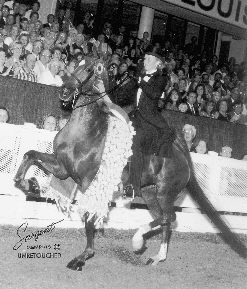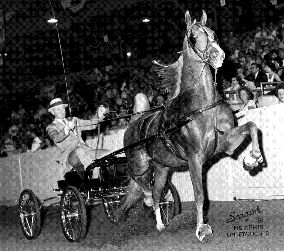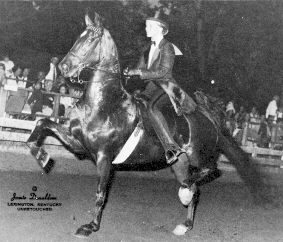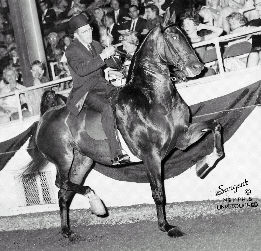The Park Trot: An Almost Lost Art
Wednesday, February 20, 2008
by Ann Bullard
We hear a lot about it. Announcers call for it, but do we ever see a true park trot? In the Saddlebred world several world’s champion trainers and breeders answer quite rarely.
The USEF Rule Book in the American Saddlebred section describes the balanced trot as featuring “coordinated motion, with straight, true shoulder motion of front legs with flexing hocks carried close together. It is executed in a highly-collected manner and should display the horse’s athletic ability. The USEF clarifies its trot as being one of “coordinated motion with straight true folding action of the front legs with flexing hocks carried close together, producing a clean, rhythmic and fluid way of going.”
Obviously, the trot itself is different for horses in each division. “The park trot for a three-gaited or fine harness horses as one to be executed in highly collected manner, with speed to be penalized. The horse’s energy should be directed toward animation rather than speed.”
Saddle Horse Report asked Reedannland’s Dr. Alan R. Raun, trainers Peter Cowart, Carter Cox, Jim Lowry, Mike Roberts and Sandy Sessink about the park-trot today.
“It’s gone,” Roberts said. “Because of the way most horses have been bred in recent years, they have to have a little more speed to get their motion. We’re not breeding as naturally gifted horses as we used to.”
“A beautiful walk-trot horse should go a square, four-corner trot,” world’s champion trainer Carter Cox said. “If its front motion is going as high as the rail, you ought to see the hock up there just as high. That’s more important on a walk-trot or harness horse than a gaited horse.”
Cox, who started World’s Grand Champion CH A Sweet Treat, says the way a walk-trot horse moves “has to do with breeding, training and custom. I think that Valley View Supreme and that bloodline tended not to have [as much] forward motion. They had to step up at the trot to get their motion. That has prevailed over the years.

CH A Sweet Treat is one of the ‘modern’ horses with
that ‘old-fashioned trot.’ Already a World’s Grand
Champion in fine harness, she wore the roses from
Louisville’s 1999 three-gaited championship.
“When I was with Mr. Bradshaw, he had colts for Mrs. [Judson] Large by Genius Bourbon King and some of the first Valley View Supremes. They were gorgeous. A lot of times they could go off their hocks, but were a little short-legged,” said Cox, explaining the back end is the source of a horse’s impulsion.
Can you train a horse to park trot? Our panel agreed it’s not easy and virtually impossible unless it’s bred into them.
“Training a park trot takes lots of collection, mouthing and timing – sort of a lost art in training,” Cox added. “Mr. Bradshaw was a great man to bridle and ‘schooled up’ a horse. He could get motion out of a lot of horses; I never learned exactly what he did. You can primp a horse to trot; it depends on how you extend it from there. You want to keep a horse’s fanny up to the front end, keep it keyed up and keep the trot.”
Mike Roberts spoke of the fine harness horses, particularly World’s Grand Champions CH Colonel Boyle and CH The Lemon Drop Kid. “You don’t see that kind of motion any more. You can certainly enhance it with correct bridling and shoeing, but you can’t put it on a horse that doesn’t have it naturally. I don’t think trainers spend enough time developing it. I think that motion is more in a horse’s mouth than in its legs.

The only American Saddlebred to grace the cover of
Sports Illustrated, The Lemon Drop Kid and Jay Utz
set the standard for fine harness horses. His only
defeats came near the end of his career when Art
Simmons and the great stallion, CH Colonel Boyle,
won the World’s Champion Stallion and Gelding Fine
Harness title and the World’s Grand Championship.
“We’re just not breeding as naturally gifted horses as we used to,” he added. “A horse’s foreleg has to be on the point of its shoulder. If it’s set back five to eight inches, the horse can’t put its forearm up where it belongs. Today, one in 100 colts just throws its head and tail up and park trots around the field. You used to see 15 or 20 out of 100 that would throw its tail up and ‘barnyard.’”
Dr. Raun agrees. “A park trot should be a slower-motioned trot; the horse should spring off its hocks. A real good three-gaited horse is supposed to have only one speed, collected and highly animated with action off both ends. You can take it away, but a horse has to have it in them.”
Peter Cowart addressed the difference in ‘styles.’ “The park trot isn’t as important any more; the picture in a magazine and the horse’s image are. If a horse has a good neck, many don’t notice or care what’s underneath. A horse that’s broke in two (out of time) can’t do it.”
Cowart contends that a horse can be taught to park trot, although having the natural ability to do so certainly helps. “It will separate a lot of walk-trot horses. Sometimes a good head set carried right and a great trot is more important than just a great neck and weak underneath. Things like that come and change over time. We shouldn’t have to wait 10 years for a new generation of horses to come by before we judge the true park trot.”
Robert Gardiner of Landmark Farm brings a younger trainer and judge’s perspective to the Saddlebred question. “That type of trot is a very hard thing for a horse to do. They have to be so strong behind and step off all four. That kind of horse is hard to find.
“A lot of it is the horse you have to train. A horse like Lady Vol has that natural way of going. You have to have a horse that’s geared that way; you can’t make it do that on your own,” he said, adding we see one or two horses that trot that way every year.
Gardiner says that the industry’s becoming so amateur-oriented also presents a challenge. “It’s hard for an amateur to present a horse at the park-trot fashion. We trainers stand on the rail and urge a rider to go on. We mean step up and ride to the best of their ability. That often gets translated into a big race.”
Sandy Sessink is best known for her years spent with the Morgan breed and as an equitation instructor and judge. She lays part of the trotting problems on the rider. “People are trying harder and harder to get the most out of their horses at the trot. They don’t realize that they should push for power rather than for speed. Going too fast is an overriding kind of thing. You’re pushing for collection; people try too hard and lose the whole point of it.”
Sam Brannon trained multi-world’s champion CH Valley Witch, who began her Louisville winning streak in 1971. Marie Brannon won Amateur Three-Gaited titles with the mare in 1972, ’73, ’74 and ’76. She is one mare remembered for her true, four-cornered, park trot.

CH Valley Witch and Marie Brannon
“She was all natural, with each foot in the right place,” Brannon recalled. “The only reason we put shoes on her was to keep her balanced.”
CH Delightful Society, by Society Rex and out of the Broodmare Hall of Fame mare, American Honeysuckle, was undefeated in world’s championship competition. Carter Cox describes her as “not pretty, but she had everything else.”

CH Delightful Society, by Society Rex, is remembered
as one who performed as many think a walk-trot horse
should. “She wasn’t pretty, but had everything else,”
Cox said of the mare. She won the Three-Year-Old and
Junior Three-Gaited World’s Championships in 1956 and
the 1959 over 15.2 and World’s Grand Championship
with Owen Hailey in the irons. In 1960, Eddie Boyd rode
her to the over 15.2 and World’s Grand Championship.
The Morgan park trot is defined a little differently than that for the Saddlebred. The rulebook describes it as “animated, square, collected and balanced.”
Sessink addressed the Morgan question. “It’s been a matter of breeding for certain things; others have gone by the wayside. It seems to me that a good cadenced trot has become almost secondary to an extreme front end. We’re losing the point. If a horse doesn’t have back end to go with it, to make it carry itself with cadence …” She paused and continued, “So many horses are mixey gaited. They’re not trotting true enough to get the extreme motion they need.”
Jim Lowry has trained numerous world and Grand National Champion Morgans. He expanded into the Saddlebred world in the last few years. He spoke about the park trot in both breeds.
“That trot probably has been bred out and trained out of the Saddlebred,” he said. “What I’ve seen is too many people caught up with riding hard and ‘going for it.’ If you go in and do a slow, four-cornered trot, a lot of people will bust on past you.
“I don’t see too many trainers go in and show a real slow, marchy park trot. It’s been a long time since we’ve seen Starina or someone like that. I’m not sure if we’ve gotten away from the trend or lost sight of what a walk-trot horse started out to be. The old-fashioned trot is so much finesse. If judges pick finesse over charger, faster moving horses, then finesse is what a trainer will do.
“The same trend happened in Morgans. We started breeding prettier, hookier-necked, pretty-eared, cleaner-boned horses and getting away from the athletic ones,” Lowry said.
Whether it’s breeding, training or simply trends, our panel agree that the gait has changed. Is the trot better today or just different? Which is better? That’s a question to be answered in the show arena.
|